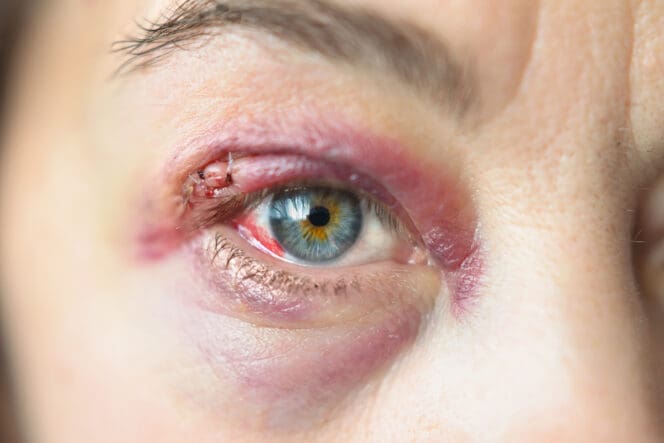Eyelid Cut (Laceration): Causes and Treatment
Eyelid cuts are tears in the soft skin that covers the eyes and skin in the immediate surrounding area. Children are prone to getting lacerations in this area.

Adults who get eyelid cuts usually do so because they have an active lifestyle or because they have a hands-on job.
Many cuts to the eyelid go away on their own, and others require minor treatment that involves cleansing and bandaging. Some cuts are serious enough to need stitches.
What Are Eyelid Cuts?
Eyelid lacerations are partial or whole defects in the eyelid that make up a subset of facial trauma. They may be accompanied by various ocular injuries, including orbital fractures, corneal abrasions, open globe and lacrimal drainage system disruption.
Most eyelid complications are not serious and disappear on their own, others affect your eye and cause you vision issues.
While people often ignore eyelid lacerations, these injuries require immediate medical attention when possible. Proper and effective eyelid trauma management can reduce the chances of the damage worsening or developing to your eye.
Types of Injuries Leading to Eyelid Cuts
Active children represent a large portion of people who experience eyelid cuts. The most common types of injuries that lead to them are handlebar-related bicycle injuries and attacks (or bites) from dogs. Crashing into heavy or sharp objects like store displays, hooks and sticks may also result in eyelid lacerations.
Contributing factors to cuts in teenagers and adults usually involve fighting and playing sports. A recent study details that men are more likely than women to get eyelid cuts. The study broke down places and events where the eyelid injury occurred. In short:
- 44 percent of them happened in the streets
- 29 percent of them took place while at home
- 19 percent of them happened in the workplace
What Causes Eyelid Lacerations?
The skin around the eye is usually soft. Eyelids, for example, need to stretch when you blink or close your eyes. However, the skin can’t be heavy or bulky as it might damage the eye. These characteristics are what make the skin around your eyes susceptible to damage.
Aside from trauma, eyelid lacerations and swelling may be the result of certain conditions and diseases. These include:
- Conjunctivitis or pinkeye
- Stye (an infection that develops where the eyelash connects to the eye)
- Allergies
- Graves’ disease (an autoimmune condition that affects your thyroid and can lead to eyelid injury)
Eyelid Injuries and Vision
When most people think of the eye, they do not consider the eyelid. However, damage to the eyelid can have untold effects on your eye. While the eye’s outermost layer is skin, the part beneath the skin is interconnected by various muscles.
Eyelid muscles are what help you close and open your eyes properly. Even without reaching the eye, damage to the eyelid can affect various vision factors.
For example, eyelid lacerations that damage the aforementioned muscles can take away your ability to open and close your eyes at will.
Another vision complication that may arise from damaged eyelids is chronic euphoria. Also called watering eyes, chronic euphoria is a condition describing damage to the lacrimal duct, which is what helps drain excess tears into the nose.
Who Is at Risk of Getting Eyelid Lacerations?
Anyone with eyes is at risk of getting an eyelid cut. But people who are most susceptible are those who lead more active lifestyles or who work in professions in which their body plays a key part. Such as:
- Sports activists: Contact sports like football, wrestling, rugby, soccer, boxing, MMA and hockey can increase your chances of getting eyelid cuts. Fishing can also endanger eyes and eyelids.
- High-intensity jobs: Professions like lumberjacking, construction and carpentry are more likely to cause eyelid lacerations. Professional athletes also have a higher risk.
- Beauty product users: Some makeup and beauty products are sharp and require delicate handling.
- People who get into fights: This is a common way for someone to end up with eyelid damage.
Treating Eyelid Cuts
How to treat lacerations to the eyelid largely depends on injury’s extent of the injury and how it came about. If damage is minimal, you’ll likely get away with having the wound disinfected, cleaned and dressed.
If the damage is extensive, you may require sutures or surgery.
Ideally, you should keep away from strenuous activities after eyelid cut treatments. In addition, you should follow the cleaning instructions given by your doctor to avoid infections. If you experience any of the following symptoms after eyelid laceration treatment, you should contact your doctor immediately:
- Fever higher than 100 degrees
- Increased swelling and pain
- Discharge from around the eye or wound
- Increased redness in the area surrounding the wound
Eyelid Lacerations in Children
Eyelid cuts in kids can present differently than in adults. For example, the only noticeable sign of eyelid damage in kids could be bleeding. In some instances, the laceration could directly affect the eye.
The healthcare provider can diagnose eyelid lacerations in a child through physical examinations. An eye care provider may be required for further assessment.
Kids may not react the same way as adults, so it’s important to rush them to the hospital when you notice eyelid damage.
Treating eyelid cuts in kids will depend on the child’s symptoms, general health and age. Common treatment options include getting stitches and corrective surgery.
References
-
Watering Eyes. (September 2021). National Healthcare Service.
-
Management of Eyelid Lacerations. (January 2018). Kerala Journal of Ophthalmology.
-
Clinical Characteristics and Causality of Eye Lid Laceration in Iran. (March 2013). National Center for Biotechnology Information.
-
Management of Eyelid Trauma. (May 2011). University of Michigan, Department of Ophthalmology.
Last Updated May 3, 2022
Note: This page should not serve as a substitute for professional medical advice from a doctor or specialist. Please review our about page for more information.